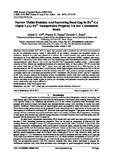Narrow Visible Emission And Narrowing Band Gap In Ho3+ -Co Doped Y2O3: Eu3+ Nanopowders Prepared Via Sol- Combustion Route.

View/
Date
2017-12Author
Abdub, G. Ali
Dejene, Francis B
Swart, Hendrik C.
Metadata
Show full item recordAbstract
Nanocrystalline Eu3+, Ho3+co-doped Y2O3 powders with a maximum size of 9.8 nm were prepared by the sol-combustion process, using Y (NO3).6HO2 as an oxidizer, europium and holonium nitrates as activators, thiourea as a fuel and ethanol as a solvent. The crystal structure and optical properties were investigated by X-ray diffraction (XRD) patterns, Scanning electron microscope (SEM), equipped with energy dispersive X-ray (EDX), Ultra-violet visible (UV-Vis) spectroscopy, and Photoluminescence (PL). As Holonium concentration (x) varies from x = 0.1 to 0.5, the Y2O3:Eu3+:Ho3+nanopowder exhibits a body – centred cubic structure of Y2O3 without any significant formation of a separated EuO2, or Ho2O3 phase. UV-Vis reveals that the optical band gap of Y2O3:Eu3+:Ho3+x alloys show red shift with increase in x. With increase in Ho
concentration (x), the PL spectra show several narrow visible light emission outspreading from 450 to 650 nm with monotonous red shift attributed to both the intrinsic Y2O3:Eu3+: Ho3+x property and the introduction of vast crystalline defects due to the high concentration of Ho3+ substitution. The presence of Eu3+ and Ho3+ impurities in the Y2O3 structure induced the formation of new recombination centres with lower emission energies and shows direct modulation of band gap. This method has proven to be ideal and simple to synthesize material for devices operating in the visible region as well as for developing heterojunction structures for optoelectronic device applications with desired efficiency.
